Harvesting chives is not difficult, but it is a little different than some of your other herbs. In this post, you’ll learn when and how to pick chives for the biggest and best harvest.
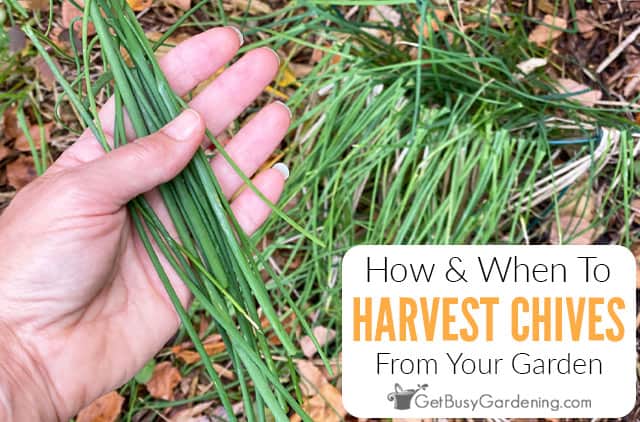
![]()
Harvesting chives sounds easy, but it can be tricky if you’re not sure how to do it. When I was a newbie, I thought I needed to dig up each individual bulb (like the green onions you buy at the grocery store).
My plants are mature and very dense, making the task of digging up only a few bulbs pretty much impossible.
When I tried it, there was so much woody old growth included, I couldn’t even eat them. It was gross.
Plus, most of the tiny bulbs were cut or crushed in the process, and that wasn’t pretty. Well, as it turns out, I was making the task of harvesting chives way too difficult.
That’s why it’s important to know how and when to harvest chives for the best results. If you do it at the wrong time, or cut the wrong part of the plant, you’ll end up with inedible woody sticks.
Don’t worry, I’ll show you exactly when and how to do it. The best part is that these instructions work no matter if you have regular or garlic chives, or any other variety for that matter!
When To Harvest Chives
One of my favorite things about chives is their super long season. They are always one of the first things I can harvest from my garden in the spring, and they last well into the late fall/early winter.
You can harvest chives whenever you want, but the best time to do it is either before or after they flower. You can also pick them while they’re blooming, as long as you know which part to cut.
The flowers are edible too, so you get a double bonus from this plant. The best time to harvest chive flowers is when they are brand new and bright purple. Once they start to turn brown, they will be too tough, and not as flavorful.
Related Post: How To Grow Chives At Home
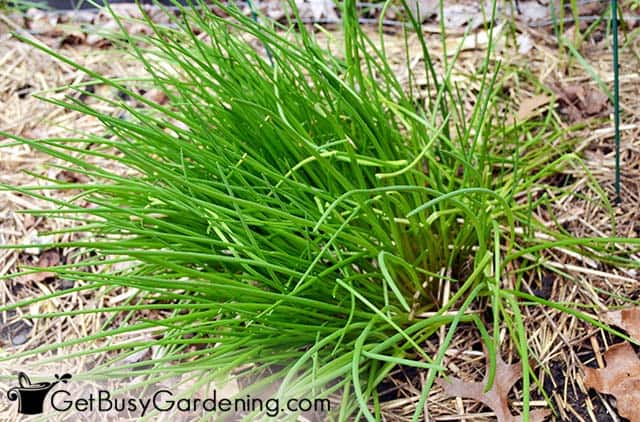
Garden chives ready to harvest
What Part Of Chives Do You Use?
All parts of chive plants are edible, including the bulbs, foliage, and flowers. Of course, the most common part to use is the tender new leaves.
Well established clumps tend to have lots of old growth mixed in. Yellowish or brown leaves, and dead flower stalks will be woody and inedible.
So, be sure to cut only the freshest, greenest new parts, and discard any of the other yucky stuff.
How To Harvest Chives
The exact steps for harvesting chives will depending on whether you want the leaves or flowers. Below I’ll show you how to pick each of them.
Harvesting Chive Leaves
The fastest way to harvest chives is to snip off the fresh leaves. You can cut each one all the way down to the ground, or just pluck off the tips.
To make it even easier, grab a handful of the tender green foliage, and cut it off all at once. I use my kitchen shears, but you could use a sharp pair of garden snips, or even bonsai shears.
Collect them in your hand, or drop them into a bowl or basket as you cut them. Just keep them out of the direct sunlight as you work, otherwise they will quickly start to wilt.
Related Post: Free Garden Harvest Tracking Sheet & Guide
Picking Chive Flowers
Chive flowers are just as easy to harvest as the leaves. Simply pick them with your fingers, or cut them off if you prefer. You could also cut the flower stalk all the way down to the base to remove it.
Just be sure to discard any part of the flower stem before use. Though edible, the stems are thick and tough, so they aren’t really great to eat.
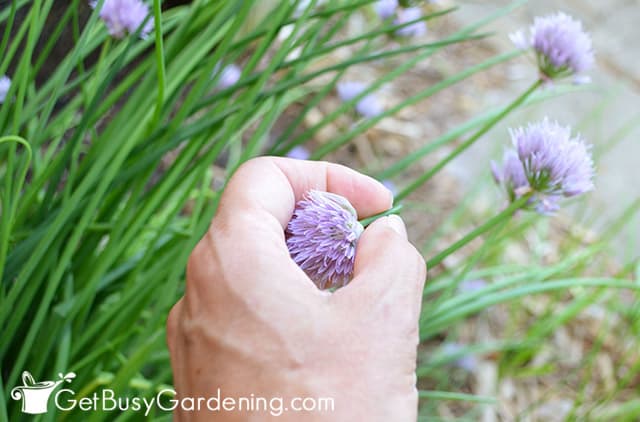
Harvesting chive flowers
How Often Can You Harvest Chives?
You can harvest chives all season long. I start cutting them as soon as the fresh new leaves emerge in early spring, and continue doing so until the cold weather kills the foliage.
Even if you cut the plant down to the ground after it blooms, you can still continue harvesting from it. They grow back very quickly.
Related Post: How To Prune Chives & Deadhead The Flowers
What To Do With Fresh Chives
Fresh chives are great for cooking, delicious in salads, and can be used in countless recipes. I especially love them with eggs and in soups, or sprinkled over any meal to enjoy the mild onion flavor.
The flowers can also be used in salads, to add wonderful color as a unique garnish, or sprinkled over the top to fancy-up any dish. Some people even use them to infuse olive oil or make herb butter. Yum!
You can even keep them for longer term use. That way, you can enjoy their wonderful garden fresh flavor all year long! Learn how to freeze chives here.
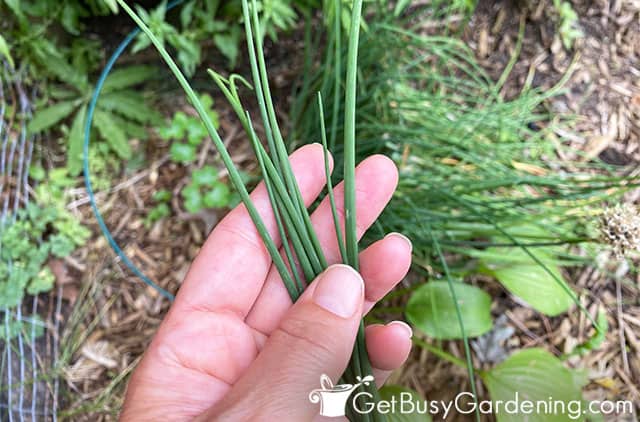
Picking fresh chives from my garden
Washing Fresh Chives
I rarely find it necessary to wash chives after harvesting them. They stand tall, so dirt doesn’t usually splash up on the leaves.
However, if you need to clean them, you can either give them a quick rinse in the sink, or swish them around in water for a few minutes.
Just fill a bowl with water, and add the chive leaves. If they’re really dirty, you can soak them for a few minutes. Then gently swish them in the water, and drain. Repeat until the water is clear.
Once clean, you should either pat them dry with a towel, or spin dry them with a salad spinner (this is my preferred method, and it gets the job done much faster!).
I don’t recommend washing the flowers, or they might not look as good afterward. I have never tried it myself though.
Related Post: How To Harvest Chive Seeds & Save Them
FAQs About Harvesting Chives
Here you will find some of the most commonly asked questions about harvesting chives. If you don’t see your answer here, ask your question in the comments section below.
Can you harvest chives after they flower?
Yes! Chives do not lose their flavor after flowering. So you can continue to harvest them all summer long, before, during, and after blooming.
Do chives grow back after cutting?
Yes, and they grow back fast. Within 2 to 3 weeks after cutting them down to the ground, your chive plant should be big enough for you to harvest again.
Can you eat chive bulbs?
Yes, you can eat chive bulbs. However, when the plant is mature, the bulbs can be extremely difficult to dig up.
So it’s easiest to just eat the leaves or flowers, instead of trying to harvest the individual bulbs.
Can you eat chive seeds?
Yes, chive seeds are edible. They are very hard, so you would need to grind them into a powder in order to eat them.
However, they don’t have a very strong flavor, and that’s why they aren’t a popular culinary spice.
Harvesting chives is very easy when you know how to do it. Even the most novice gardener can do it expertly with a little instruction. Your reward will be to have delicious garden-fresh chives to add to your favorite soups, salads, and dishes all season long.
More Garden Harvesting Posts
- How & When To Harvest Sage Fresh From Your Garden
- How & When To Harvest Parsley
- When & How To Harvest Rosemary Leaves & Sprigs
- When And How To Harvest Tomatillos
- How To Harvest Lavender Fresh From The Garden
- How & When To Harvest Basil Leaves
- How & When To Harvest Aloe Vera
Share your tips for harvesting chives in the comments below!
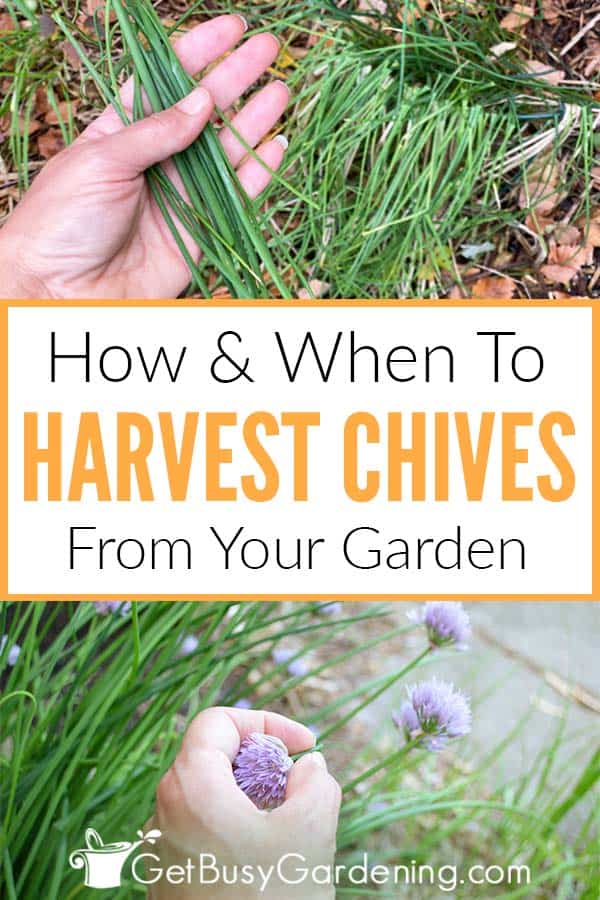
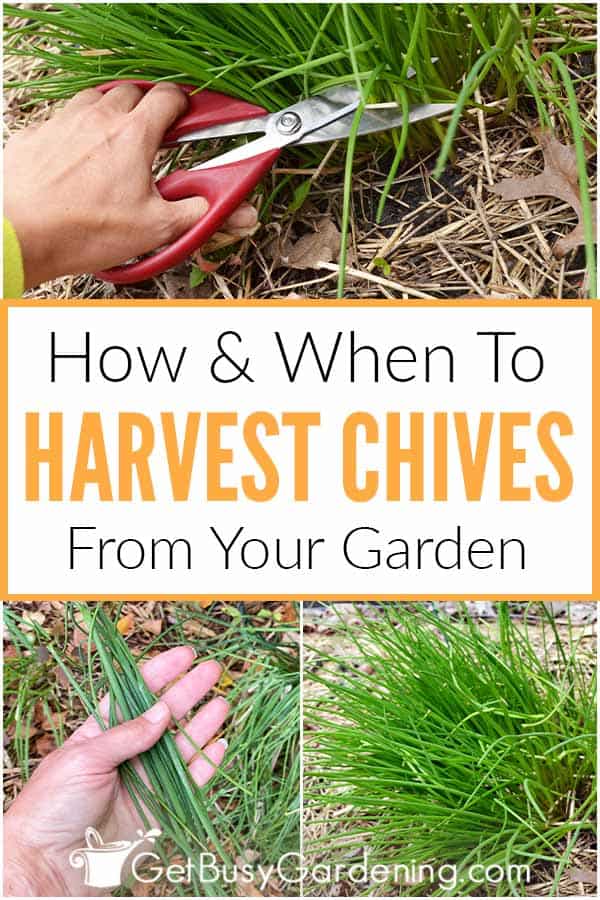
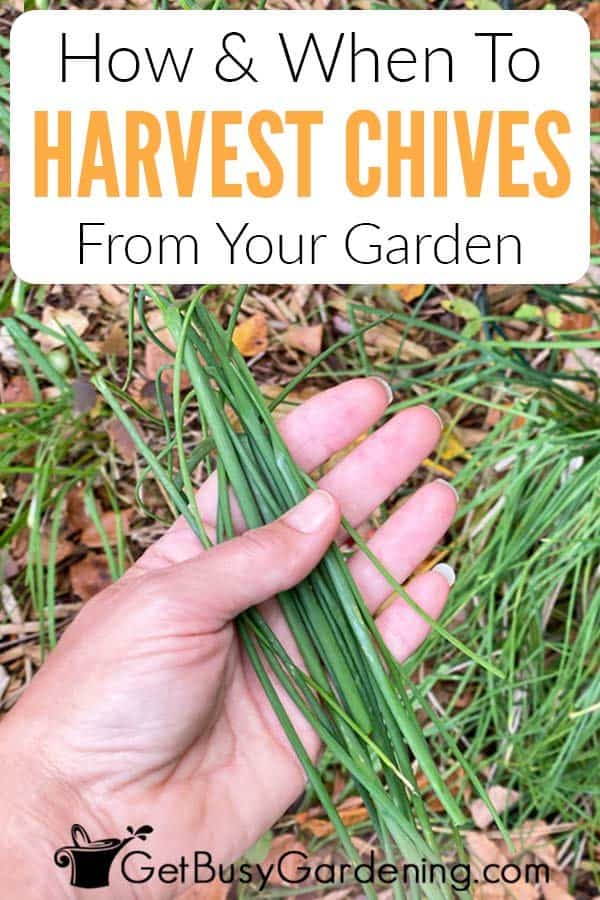
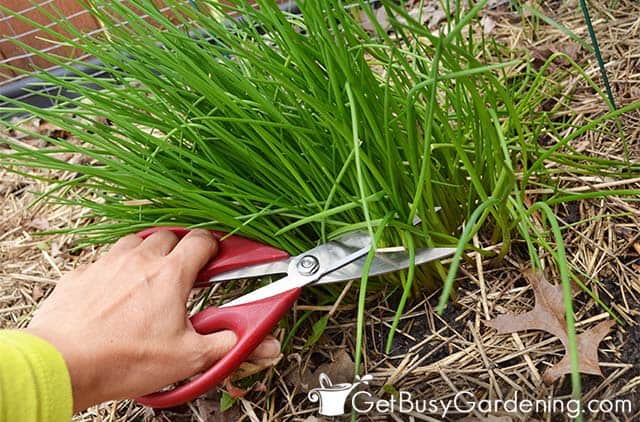

Krystle says
Hi Amy! Thanks for this info, as always! I’m in 4B too, and haven’t had much luck with chives so far this year. I started some from seeds and also planted one plant that I bought. Will they get bigger each year? My mint has spread like wildfire, but my chives are so small that I’m afraid to even clip some off. Any idea what I’m doing wrong, or do these guys just take some time/years to get full like the ones in your picture?
Amy Andrychowicz says
You’re welcome! Yes, they will get bigger each year, as long as they get enough sun. Chives need full sun to grow their best. They will be much smaller in the shade, but still produce plenty for harvesting. Here’s my complete guide to growing chives for more info. 🙂
Brenda Tijanic says
Just wondering if the mint and chives are in the same pot? If yes that is why the chives don’t grow as the mint is an invasive herb and will stop the chives from growing.
Amy Andrychowicz says
If they are in the same pot, then yes, the mint certainly could crowd out the chives. However, it won’t stop the chives from growing when there’s enough room.
Crystal says
This is very informative information for me because I know NOTHING about gardening at all. I was surprised to even find out that chives had flowers on them. (I just love to use them in my recipes.)
Amy Andrychowicz says
You’re welcome! Chives are even better when harvested fresh from the garden. Enjoy!
Shelly says
Love the flowers on the chives. Mine have never done that! I love letting the herbs go to sed and flower.. some of them like my pineapple sage are so beautiful!
Joanne Tipler says
I make sure to break up the lovely chive flowers and spread them throughout our Salad Greens. I also sprinkle them over just about everything we eat.
Amy Andrychowicz says
Awesome! Yes, chive flowers are delicious, especially right after harvesting! It’s a great way to use the whole plant! Thanks for sharing!
Chrissy Rex says
I always have about 7 complete yields of chives outside from cutting them completely back every few weeks in northeast USA. I also grow then in our Living Ledge window gardens all year inside using the same method, cutting completely back every few weeks never allowing to flower. I do use fish emulsion as fertilizer 2 times per year and repor as necessary. I think they are one of the easiest herbs to grow. Thanks for a great post and for helping people understand how
Super simple it is to grow their own !
Amy Andrychowicz says
Wow, that’s wonderful! Yes, they are super easy to grow, and very prolific too. Thanks for sharing your tips for getting the best and biggest harvest.
Carole Coates says
I’d like to hear more about more ways to use chives, especially frozen.
Anonymous says
I have had chives for years and years. They now occupy 3 10" pots, and I move them around for sun (Florida patio). They do the job 12 months of the year. Fertilize now and then, add more soil whenever, and enjoy. I chop and us, then freeze what's left over. They surely are tolerant! They do better in pot with "super" soil than in the sand of Florida. Lots less
Amy Andrychowicz says
Wow, it’s great that you’ve had them for so long in pots! You can harvest them year round too, wonderful! Some winters are mild enough here in Minnesota that we could harvest chives though most of the year, but definitely not once the cold and snow sets in.
Anonymous says
question though, I have a large chive plant, but how do I preserve them? in stores you buy the freeze dried, but what about these? chop and freeze, dry out? I don't know where to start lol
Amy Andrychowicz says
You could freeze them; or if you have a dehydrator, you could dehydrate them. Here's how I preserve my chives… How to Freeze Chives
Anonymous says
Stupid question: Where can I get chives? Can you start them from seed, or do you buy the whole plant at a nursery?
Amy Andrychowicz says
Yes, you can grow them from seed or get them from a nursery (probably small starts rather than whole plants). They are super easy to grow from seed. In fact, they are so easy that you have to deadhead them to keep them from spreading around too much. Just keep in mind that chive seeds are only viable for about a year, so make sure you buy fresh seeds and plant them soon after.